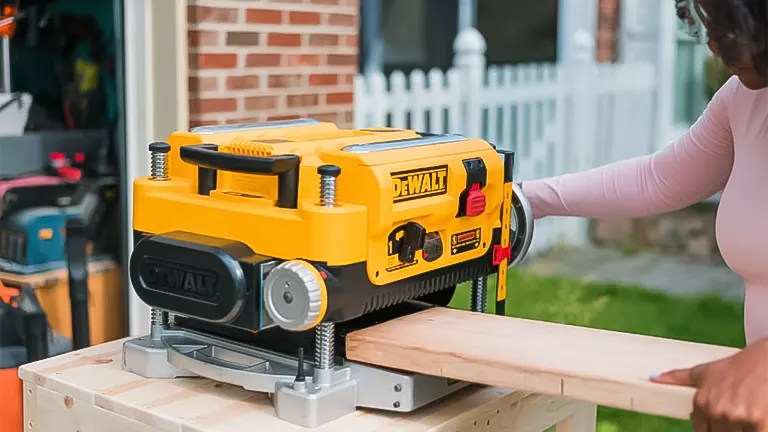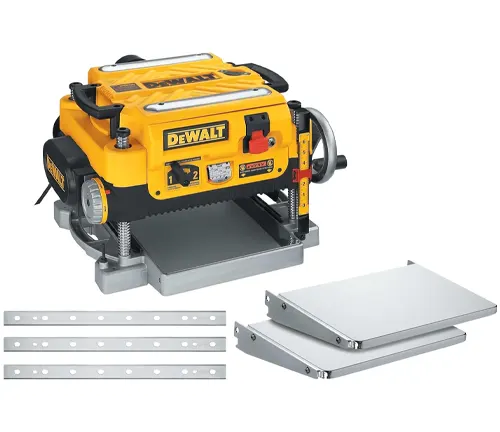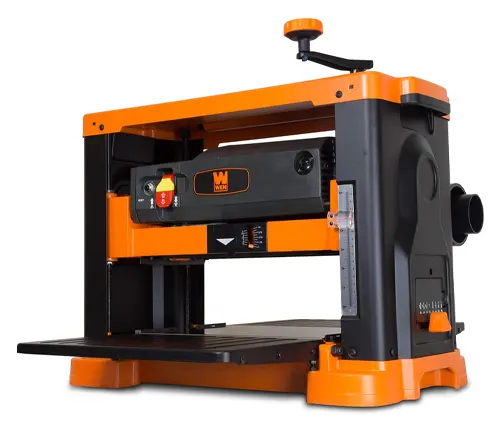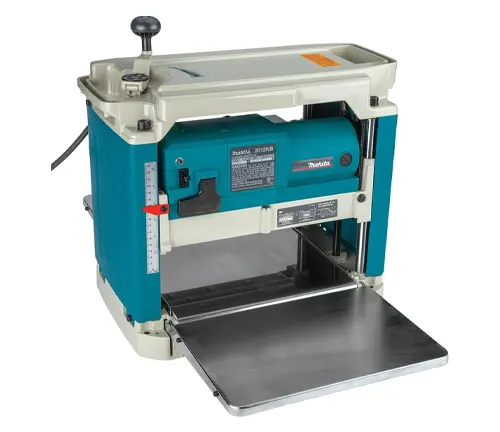Best Wood Planer for the Money: Best Value and Performance 2025
- March 18, 2024
- 0 comment
Discover the Best Wood Planer for the Money in our comprehensive guide. As an experienced woodworker, I’ve tested a wide range of planers to find the perfect balance of quality, performance, and affordability in the ever-evolving world of woodworking tools. It’s been a journey marked by both excitement and challenges, as the search for a wood planer that excellently balances quality, performance, and affordability is quite a demanding endeavor given the dynamic landscape of woodworking tools.

I’m eager to impart the knowledge and firsthand experiences I’ve gathered, aiming to navigate you towards the top 4 wood planers. These selections stand out not merely for their value for money but also for their dependable performance, promising to be steadfast allies in your woodworking projects.
Best Wood Planer For The Money 2025 List:
- DeWalt DW735X Two-Speed Thickness Planer
- WEN 6552T 13-Inch 3-Blade Benchtop Thickness Planer
- Makita 2012NB 12-Inch Planer
- CRAFTSMAN CMEW320 Benchtop Planer
Comparison Table By Each Model
Here’s a more condensed comparison of the wood planers:
| Model | Type | Power | Blades | Max Width | Unique Feature | Portability | Best For |
|---|---|---|---|---|---|---|---|
| DeWalt DW735X | Two-Speed Thickness | Electric | 3 | 13″ | Two-speed gearbox, fan-assisted chip ejection | Benchtop | Professional, high-volume |
| WEN 6552T | Benchtop Thickness | Electric | 3 | 13″ | Tri-roller feed, fan-assisted dust port | Benchtop, portable | Value, mid-level projects |
| Makita 2012NB | 12-Inch with Interna-Lok | Electric | 2 | 12″ | Automated head clamp, low noise | Benchtop, lightweight | Precision, quiet operation |
| Bosch PL2632K | With Carrying Case | Electric | 2 | N/A | Dual-mount fence, ergonomic design | Handheld | Detail work, edge planing |
| PORTER-CABLE PC60THP | Hand Planer | Electric | 2 | N/A | Heavy-duty motor, dual dust extraction | Handheld | Quick jobs, edge work |
| CRAFTSMAN CMEW320 | Benchtop Planer | Electric | 2 | 12″ | Quick-change knives, cutter head lock | Benchtop, portable | Hobbyists, small-medium projects |
This streamlined table gives you a snapshot of each model’s type, power source, blade count, maximum cutting width, standout features, portability, and ideal user or project type.
1. DeWalt DW735X Two-Speed Thickness Planer
Technical Specifications
- Brand: DEWALT
- Model Number: DW735X
- Style: 2-Speed 13″ w/Feed Tables & Extra Blades
- Material: Plastic
- Base Material: Aluminum
- Power Source: Corded Electric
- Voltage: 120 Volts
- Amperage: 15 Amps
- Product Dimensions: 21.75″L x 24.25″W x 22″H
- Item Weight: 92 Pounds
Starting strong with the DeWalt DW735X, this planer stands out for its exceptional performance and durability. Its two-speed gearbox allows for versatility in managing both rough dimensioning and finer finishes.
The inclusion of a fan-assisted chip ejection system is a game-changer, keeping the work area clean. Although on the pricier side, the DW735X justifies its cost with a powerful 15-amp motor and an extra set of knives, ensuring longevity and uninterrupted workflow.
Pros
- Robust build, two-speed gearbox for versatile planning, effective chip ejection.
Cons
- Higher price point, relatively heavy.
2. WEN 6552T 13-Inch 3-Blade Benchtop Thickness Planer
Technical Specifications
- Brand: WEN
- Model: PL1303
- Color: Black & Orange
- Style: Benchtop
- Power Source: Corded Electric
- Product Dimensions: 28.25″L x 20″W x 24″H
- Item Weight: 78.8 pounds
- Included Components: Benchtop Planer
- Pattern: Planer
The WEN 6552T is the epitome of value for money. Featuring a three-blade design, it delivers exceptionally smooth finishes on a wide variety of woods.
Its 15-amp motor effortlessly handles deep cuts in hardwoods, making it a fantastic option for budget-conscious woodworkers who don’t want to compromise on quality.
Pros
- Affordable, three-blade design for smoother finishes, powerful motor.
Cons
- Dust collection could be better, durability may not match higher-end models.
3. Makita 2012NB 12-Inch Planer
Technical Specifications
- Brand: Makita
- Model: 2012NB
- Color: Factory
- Power Source: Hand Powered
- Product Dimensions: 30.35″L x 19.02″W x 15.79″H
- Item Weight: 28.07 Kilograms (61.8 pounds)
- Size: One Size
- Voltage: 120 Volts
The Makita 2012NB shines in the portability department, making it an ideal choice for those who need to move their planer between worksites or tuck it away after use.
It offers impressive performance with minimal snipe, thanks to its Interna-Lok head clamp. The noise level is surprisingly low, which is a significant plus for shared workspaces.
Pros
- Lightweight and portable, low noise, minimal snipe.
Cons
- Price may be high for hobbyists, limited to 12-inch width.
4. CRAFTSMAN CMEW320 Benchtop Planer
Technical Specifications
- Brand: CRAFTSMAN
- Model: CMEW320
- Style: Planer
- Material: Carbon Steel
- Item Weight: 61.2 pounds
- Package Dimensions: 23.5 x 17.5 x 15.4 inches
- Included Components: (1) CMEW320 Benchtop Planer
Rounding out our list is the CRAFTSMAN CMEW320, a solid all-rounder that strikes a nice balance between performance and price. It handles a wide range of wood types with ease, and its lightweight design does not compromise on stability or power. This planer is a testament to CRAFTSMAN’s commitment to quality and affordability.
Pros
- Balanced performance and price, versatile, lightweight yet stable.
Cons
- Dust collection system could be improved, snipe control is decent but could be better.
Additional Tips For Making Decisions for Users
Here are four additional tips to help users make an informed decision when choosing the best wood planer for the money in 2025:
- Before making a purchase, assess the types of projects you typically work on. Consider the maximum size of wood you plan to plane and whether you require a planer for fine finishing or heavy-duty thicknessing. This will help you choose a planer that not only fits your budget but also meets your specific woodworking needs.
- ake advantage of the wealth of information available online. User reviews and professional ratings can provide insights into the reliability, efficiency, and overall performance of various planers. Look for consistent patterns in feedback to gauge the strengths and potential issues of each model.
- Over time, blades will need to be replaced or sharpened. Look for a planer with a straightforward process for changing blades and performing routine maintenance. Models that require less downtime for maintenance allow you to focus more on your projects and less on tool upkeep.
- The quality of after-sales support, including customer service, availability of spare parts, and warranty service, can greatly impact your satisfaction with a purchase. Brands that offer responsive support and accessible spare parts can save you time and hassle, ensuring that your planer remains in top working condition for years to come.
By keeping these tips in mind, users can better navigate the selection process, ensuring they choose a wood planer that offers the best balance of cost, performance, and longevity to suit their woodworking endeavors.
Choosing the Right Planer
Selecting the ideal wood planer is fundamentally about recognizing your unique requirements and project demands. Take into account the variety of wood you usually handle, the dimensions of your projects, and the importance of portability for your work. While budget considerations are unavoidable, opting for a model that’s a bit more costly upfront can offer long-term benefits in terms of durability and advanced functionalities.
These Four planers stand out as the epitome of efficiency, value for money, and dependability, whether in a workshop environment or on a job site. They are designed to cater to the needs of both seasoned professionals and those new to woodworking, with each tool possessing the capability to significantly enhance your crafting experience.
Final Thoughts
In the quest for the best wood planer for the money in 2025, it becomes evident that the right choice hinges on a blend of performance, durability, and value. The six planers we’ve discussed embody this blend, catering to a wide range of woodworking needs—from high-volume projects requiring professional-grade precision to smaller, hobbyist endeavors where ease of use and portability are key.
Investing in a quality planer not only enhances your workshop’s capabilities but also ensures longevity and reliability in your woodworking pursuits. As technology advances, these tools have become more efficient and user-friendly, making now an excellent time to consider upgrading or acquiring a new planer that promises to elevate your woodworking projects to new heights of craftsmanship and detail.
Frequently Asked Questions
- What is the most important feature to look for in a wood planer for 2025?
Look for a planer with a strong motor, consistent cutting depth, and smooth finish capabilities, tailored to the size and type of projects you typically undertake. - Can I find a high-quality wood planer without breaking the bank?
Absolutely. Many models offer a good balance between quality and affordability, focusing on essential features without the extra cost of advanced functionalities you may not need. - How do I choose between a benchtop and a handheld planer?
Benchtop planers are ideal for more extensive, regular work on larger pieces, offering stability and power, while handheld planers offer portability and convenience for smaller projects and fine-tuning. - What safety features should I consider in a wood planer?
Look for features like lock-off buttons, automatic shut-off, a sturdy base for stability, and dust extraction capabilities to keep the work area clean and minimize health hazards. - Is the number of blades on a planer important?
Yes, more blades can lead to smoother finishes and faster work, but also consider the quality of the blades and how easy they are to replace or sharpen. - How does the width capacity of a planer affect my choice?
The width capacity determines the maximum width of the wood that the planer can handle. Consider the typical size of your projects to ensure the planer meets your needs. - What difference does motor power make in a wood planer?
Higher motor power can handle harder woods and more prolonged use without overheating, contributing to the planer’s efficiency and lifespan. - Are there significant differences between corded and cordless planers?
Corded planers typically offer more power and unlimited run time, while cordless models provide mobility and convenience, especially for work in locations without easy access to power outlets. - How important is the dust extraction feature in a wood planer?
Very important for maintaining a clean work environment and reducing health risks associated with wood dust. Effective dust extraction can also improve the quality of your finish by removing debris from the work surface. - What warranty should I expect with a wood planer purchase in 2025?
Warranties can vary significantly by manufacturer, but a good rule of thumb is to look for at least a one-year warranty, with longer warranties offering more peace of mind regarding the product’s durability and the manufacturer’s support.
We’re eager to hear from you! Share your personal experiences and insights about the best wood planers for the money in 2025 in the comments section below. Your feedback and thoughts can greatly assist fellow woodworking enthusiasts in making well-informed decisions. Whether it’s a model you’ve used, a feature you can’t work without, or any tips you’ve discovered along the way, your contribution is invaluable to our community. Let’s help each other find the perfect tool for our projects!

Edward Smith
Forestry AuthorWoodworking is about more than crafting; it's a harmonious connection with nature, mastering tools, and preserving our environment. I'm here to share my knowledge and experiences with you, forging a future where we can embrace wood's beauty and utility while safeguarding our forests' health and diversity.

















Leave your comment